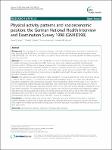Physical activity patterns and socioeconomic position: the German National Health Interview and Examination Survey 1998 (GNHIES98)
Finger, Jonas
Tylleskär, Thorkild
Lampert, Thomas
Mensink, Gert
Background: We investigated the associations between education and leisure-time, occupational, sedentary and total physical-activity levels based on data from the German National Health Interview and Examination Survey 1998 (GNHIES98). The roles of income level, occupational status and other mediating variables for these associations were also examined. Methods: The total study sample of the GNHIES98 comprised 7,124 participants between the ages of 18 and 79. Complete information was available for 6,800 persons on leisure-time, sedentary and total physical-activity outcomes and for 3,809 persons in regular employment on occupational activity outcomes. The associations between educational level and physical activity (occupational, sedentary, leisure-time and total physical activity) were analysed separately for men and women using multivariate logistic regression analysis. Odds ratios (OR) of educational level on physical-activity outcomes were calculated and adjusted for age, region, occupation, income and other mediating variables. Results: After adjusting for age and region, a higher education level was associated with more leisure-time activity – with an OR of 1.6 (95% CI, 1.3-2.0) for men with secondary education and 2.1 (1.7-2.7) for men with tertiary education compared to men with primary education. The corresponding ORs for women were 1.3 (1.1-1.6) and 1.7 (1.2-2.4), respectively. Higher education was associated with a lower level of vigorous work activity: an OR of 6.9 (4.6-10.3) for men with secondary education and 18.6 (12.0-27.3) for men with primary education compared to men with tertiary education. The corresponding ORs for women were 2.8 (2.0-4.0) and 5.8 (4.0-8.5), respectively. Higher education was also associated with a lower level of total activity: an OR of 2.9 (2.2-3.8) for men with secondary education and 4.3 (3.3-5.6) for men with tertiary education compared to men with primary education. The corresponding ORs for women were 1.6 (1.2-2.0) and 1.6 (1.2-2.1), respectively. Conclusions: In Germany adults with a lower level of education are more physically active, both at work and overall, compared to adults with a higher education level, although they are less physically active in their leisure time. Higher work-related activity levels among adults with lower education may explain why they are less active in their leisure time.
No license information

